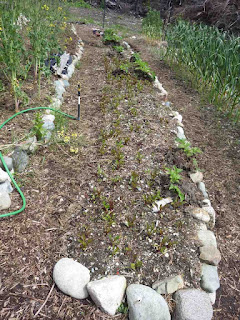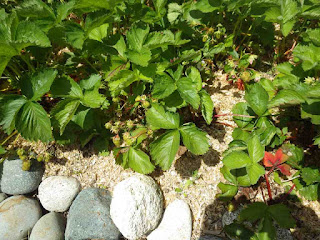Rainy Summer Solstice Waiting for the Sun
It's been a cold and rainy spring, but we try not to complain while places elsewhere suffer from plague, pestilence, war, famine, drought, heat waves, and forest fires. Check out the daily updates about what's really going on in the world at the Collapse Chronicle. Summer is supposed to come this weekend, so in the meantime let's open the gate and see what's going on inside our garden lifeboat.
This season's highlight is that we finished converting the "ShelterLogic" tarp shed into a greenhouse. We spent most of May carefully screwing a wooden frame into both metal ends and sandwiching greenhouse plastic between 1"x4" and 1"x2" slats. To fit the frame of the 10'x20' tarp shed we had bought a transparent tarp of the same dimensions from Midland Liquidators. The web-site had warned that it might be slightly smaller than the posted dimensions but it was almost a foot less. So we had to patch in some 6mil vapour barrier that should last for the summer. Thanks to advice from Gabriel at Sointula Candle Company, who has an amazing greenhouse, we realized that we need a much bigger tarp to overlap the ends and to be able to roll up the bottoms. So we will install a bigger tarp in the fall to last through the stormy winter.
Inside the greenhouse we planted tomatoes, peppers, squash, cantaloupe, eggplant, and basil. There are two black plastic water barrels which will provide overnight thermal mass when filled with water. For irrigation, we use the white Tyvek drip lines from Irrigro. Brewing in a five gallon bucket is nettle tea, a fantastic fertilizer for all the plants.

Bed #1 is the herb garden, which includes sage, oregano, sorrel, chives, lovage, dandelion, red clover, lemon balm, St. John's wort, thyme, and perennial arugula. The wildflower seed mixture is starting to sprout.
Bed #2 is full of raspberries that are starting to form little fruit. We will start transplanting them into the orchard in the fall to free up this bed for annual plants in Zone #1 closer to the cabin for more regular tending.
Bed #3 is full of heritage Sieglinde and Yukon Gold potatoes. The bed also has some St. John's Wort in the front left. Seeds for this medicinal plant were collected from Anderson Bay on the southern end of Texada Island, where there was once a logging camp. Historically, the flowers from St. John's Wort are harvested on the Summer Solstice for tincture making. We are still waiting for the yellow flowers to bloom. So are the bees who love them.
Oh dear Bed #4 is very dismal. We have seeded carrots twice now. Once under Remay at the beginning of May and four weeks later in June without Remay. Only a handful of carrots have germinated. We will try again a third time, this time a new method which involves putting boards on top of the seeds to keep them moist and dark. Wish us luck 😢😢😢😢. There is also some perennial arugula in the foreground and last year's celery going to seed, which will feed beneficial insects with its flowers.
In Bed #5, there are a few hundred red and yellow cooking onions, which should last us for a year.
Bed #6 is inter-planted with shelling peas and lettuce. There are also "Mrs. Woo's Peas" that came with the Chinese miners to the Blubber Bay quarry on Texada Island over a hundred years ago. These curly peas can grow up to 8 inches long and are excellent in stir fries.
In Bed #7, we have the remainder of the kale flowering and going to seed. After the kale plants are removed this bed will be planted with beans (appaloosa, kidney, and black), which are now germinating in the greenhouse. To give these beans a better chance in our cool climate we will put our little plastic hoophouse around them. The beans will also fix the nitrogen in the soil that was depleted by the brassicas, which are heavy feeders.
In Bed #8, there are many beets coming up. We have left some volunteer potatoes from last year to grow.
In Bed #9, the garlic just loves the cool springtime. There is the hard-neck in the front and some soft-neck hiding in back. The garlic loves it so much in this climate that it will definitely be part of our commercial expansion plans.
Bed #10 is devoted to organic potatoes that were going to seed from the Co-op Store, which are also doing very well in the cool climate. There is some parsley going to seed in the foreground,
The lowest bed #11 is devoted to brassicas, including radishes, broccoli, cabbage, cauliflower, kale, and collards. They are growing in bottomless plastic pots to protect them from slugs. One of the advantages of the cool weather is that there are fewer slugs. Once the plants get large enough, we remove the pots.
In the orchard, there is a profusion of "Juneberry" strawberry growth, but no ripe berries even though it is almost the end of June. Above the strawberries we have started to seriously mulch the asparagus and fruit trees with cardboard due to the profusion of grass growing in the orchard. We put down some sheep manure on the cardboard to keep it from blowing away and to also fertilize the plants.
Here is a close-up of the strawberries, we really hope that they ripen soon!
The fig tree is mulched in the foreground and the other asparagus bed still needs to be mulched with more cardboard in the background. Next year, we will have to transplant the figs into a greenhouse to get some serious fruit production.
One of the hazelnut trees that we brought from Texada Island is doing very well. We are now mulching around all our fruit and nut trees with cardboard to keep the grass down based on advice from Stefan Sobkowiak at the Permaculture Orchard.
Some of the cherry trees are staring to produce fruit.
Here are some nice "Green Gage" yellow plums starting to form.
And a few blueberries coming along nicely.
Our friend "Baby Deer" really likes eating all the grass. Too bad, it won't eat the swamp grass. We will have to get some goats once we build a barn.
Wilma the Cat sure loves hanging out in the garden, especially when Mummy is in there working too.


























Comments
Post a Comment